A plant with the name Mother in Law’s Tongue is sure to pique the interest of most people, gardeners or not. Whether or not this plant makes you think of your own close relation, it’s worth a closer look and is good for your health.
In this guide, we cover an introduction to Mother-in-Law’s Tongue, the common varieties, propagation methods, growing and care advice, and pests and diseases to look out for.
More...
Genus: | Dracaena (formerly Sansevieria) |
|---|---|
Species: | D. trifasciata |
Family: | Asparagaceae |
Common Names: | Mother in Law's Tongue, Snake plant, Viper's bowstring hemp, St. George's sword |
Plant Type: | Evergreen, Perennial |
Sun Exposure: | Shade to partial sun |
Soil Type: | Sandy, well-drained |
Soil pH: | Slightly acidic to slightly alkaline |
Flowering: | Spring |
Flower Colour: | White |
Maintenance level: | Low |
Toxic to pets: | Yes, to cats and dogs |
Introducing Mother-in-Law’s Tongue
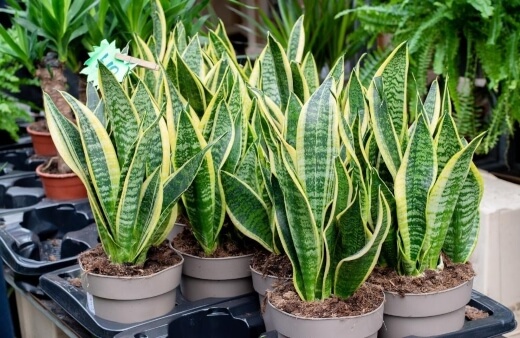
Dracaena trifasciata is a species of flowering plant in the Asparagaceae family. It is native to tropical West Africa – you’ll find it from Eastern Nigeria to the Democratic Republic of Congo.
You would probably have more commonly heard it called the snake plant, Saint George's sword, mother-in-law's tongue, and viper's bowstring hemp. Until 2017, it was actually known as Sansevieria trifasciata. Trifasciata means "three bundles”.
If you’re wondering about the name, it is commonly known by the name snake plant because of the shape and colour of its leaves. Mother-in-Law's Tongue is a name that comes from the sharpness of the leaves. Perhaps your own experience of a mother in law would confirm that this name is very appropriate!
The plant actually does well when neglected and can handle drought. It doesn’t like excessive watering, so aim for once a week and allow it to dry out between each watering.
Sometimes you might see short spikes of small, fragrant, tube-shaped greenish-white flowers in spring or summer.
Mother-in- Law’s Tongue Features
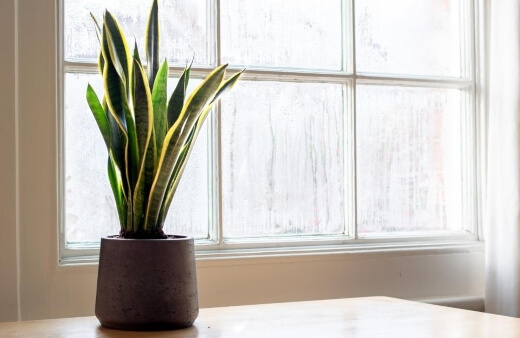
Leaves of the Mother-in- Law’s Tongue grow to between 80-100cm in length and 5-7cm wide. They are generally dark green in colour with grey-green bands and marbling.
This is probably the toughest houseplant you will ever find. It’s been described as indestructible and is a great choice for the beginner gardener. The patterned leaves are beautiful and they stay upright – perfect for a tight space that’s in need of some greenery.
Dracaena trifasciata exchanges oxygen and carbon dioxide using the crassulacean acid metabolism process. This is what allows them to handle drought. The microscopic pores on the plant's leaves only open at night to prevent water from escaping via evaporation in the hot sun.
Like some other plants from the same genus, Dracaena trifasciata produces bowstring hemp, which is a strong plant fibre that was used to make bowstrings.
Mother-in-Law’s Tongue is now mainly an ornamental plant. It does great outdoors in warmer climates, and can be kept indoors as a houseplant in cooler climates. The plant is incredibly popular because it can cope with low light levels and irregular watering.
In winter, you only need to water it once every couple of months. The plant can be propagated by cuttings or by dividing the rhizome. Dracaena trifasciata is considered a potential weed in parts of Australia, and contains saponins which are mildly toxic to dogs and cats.
Snake Plant Varieties
Dracaena trifasciata ‘Hahnii’

Also called bird's nest snake plant, it grows to only about 15cm tall. The leaf clusters form a bird's nest clump.


Get Your Free Guide:
Master Growing Australian Natives eBook
A Must Have Complete Guide for Every Australian Garden
Get Your Free Guide:
Master Growing Australian Natives eBook
A Must Have Complete Guide for Every Australian Garden
Dracaena trifasciata ‘Laurentii’
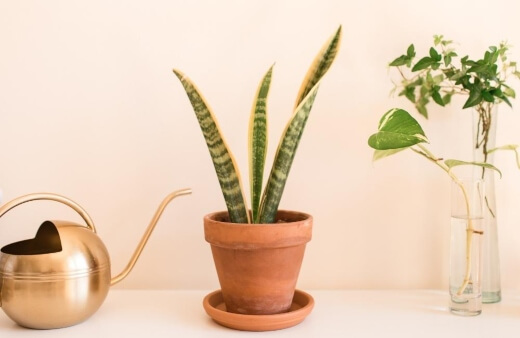
A variegated snake plant with creamy yellow leaf margins. It must be divided rather than propagated from leaf cuttings.
Dracaena trifasciata ‘Twisted Sister’
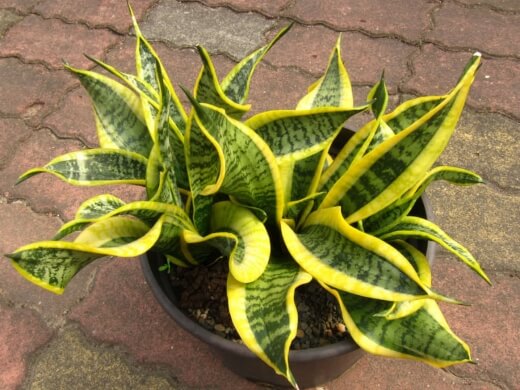
Source: worldofsucculents.com
This plant has twisted leaves striped with yellow variegated edges and grows about 38cm tall.
Dracaena trifasciata ‘Bantel’s Sensation’
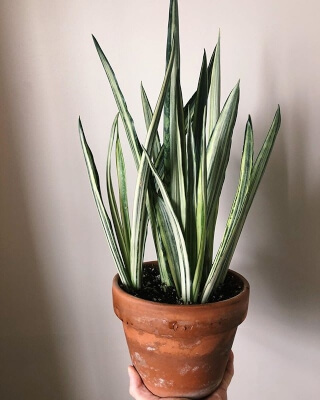
Source: chooseyourplant.com
Grows about 90cm in height and has narrow leaves with white vertical stripes.
Dracaena angolensis
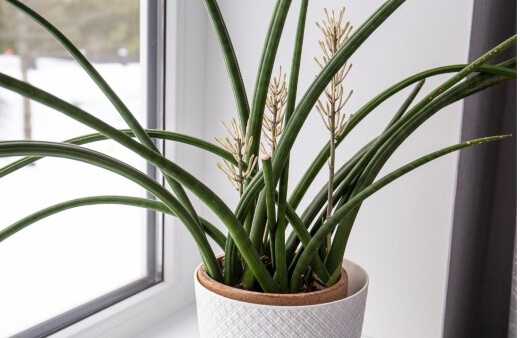
(Formerly called Sansevieria cylindrical) This snake plant like the name suggests, has a cylindrical shape, with round, stiff leaves that arch outward from a central crown.
Dracaena pearsonii
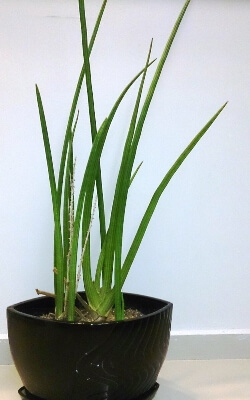
Source: hr.wikipedia.org
Sometimes called rhino grass, it grows about 5cm tall with red-tinted leaves.
Dracaena trifasciata ‘Hahnii’Also called bird's nest snake plant, it grows to only about 15cm tall. The leaf clusters form a bird's nest clump. |  |
Dracaena trifasciata ‘Bantel’s Sensation’Grows about 90cm in height and has narrow leaves with white vertical stripes. |  Source: chooseyourplant.com |
Dracaena trifasciata ‘Laurentii’A variegated snake plant with creamy yellow leaf margins. It must be divided rather than propagated from leaf cuttings. |  |
Dracaena trifasciata ‘Twisted Sister’This plant has twisted leaves striped with yellow variegated edges and grows about 38cm tall. |  Source: worldofsucculents.com |
Dracaena angolensis(Formerly called Sansevieria cylindrical) - this snake plant like the name suggests, has a cylindrical shape, with round, stiff leaves that arch outward from a central crown. |  |
Dracaena pearsoniiSometimes called rhino grass, it grows about 5cm tall with red-tinted leaves. |  Source: hr.wikipedia.org |
How to Grow Mother-in-Law’s Tongue
Mother-in-Law’s Tongue is an ideal choice for beginner gardeners. It does well in a container and grows well on the floor or on a tabletop. These plants thrive in warm weather and tend to struggle in cold conditions.
Dracaena trifasciata is drought-resistant but will suffer from overwatering which leads to root rot. Only water the plant if the soil feels dry. These plants can go two months between watering in the winter months, and in warmer months, aim for every two weeks.
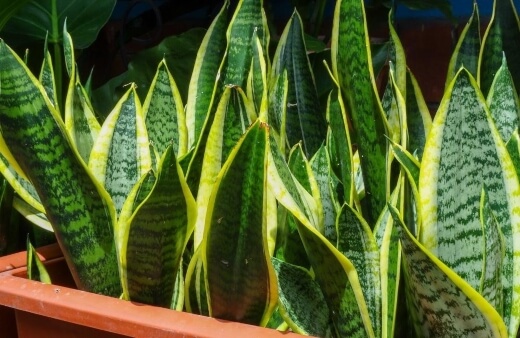
Sunlight Needs
Mother-in-Law’s Tongue likes indirect but constant light with some direct sun. What’s great is that they can adapt to full sun conditions and can equally survive dimly lit spots.
Best Soil for Snake Plants
For this plant, you need a well-drained potting mix. Dracaena trifasciata does well in sandier soils and aim for something low in peat content. Peat is great but it can become tightly packed which means it can struggle to rehydrate or drain. An all-purpose cactus potting soil is a good choice.
Temperature and Humidity
Mother-in-Law’s Tongue likes warm conditions and doesn’t do well with a temperature below 10°C. Place it somewhere where it will be protected from drafts. A temperature range between 21 and 32°C is best.
How to Propagate Snake Plants
The best time to propagate is during the growing season in the spring or summer. Dracaena trifasciata plants can be divided easily during repotting if the plant is at least 10cm tall.
You can also propagate Mother-in-Law’s Tongue via cuttings so be sure to check our guide on how to take cuttings the right way.
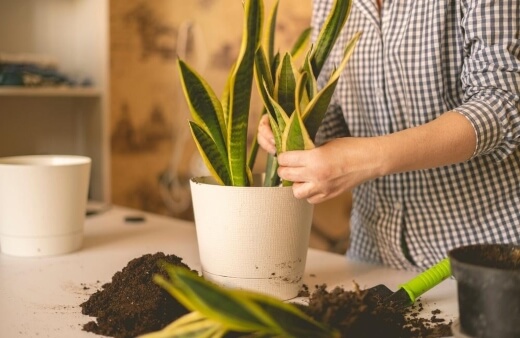
Snake Plant Propagation by Root Division
- You’ll need a sharp knife, a clean pot, and cactus potting soil.
- Pull the root ball out of the old pot and place the plant on a flat surface. Using your hand, gently brush away the soil from the root structure.
- Use the knife to divide the plant into sections, making sure the roots remain attached to each section.
- Replant the new plant sections into a clean pot with cactus potting soil.
- Water it and place in a partly sunny spot.
Mother in Law's Tongue Propagation from New Offshoots
- If you see any new offshoots that the plant has developed, you can plant those separately.
- You’ll need the same items as per root division.
- Pull the root ball out of the pot, find the offshoot's root, cut off the shoot, and plant the cut root end in the cactus potting soil.
- Water it and place it somewhere with indirect bright light.
Propagating Snake Plant from Leaf Cutting
- You can use sterilised scissors, a sharp knife, or pruning shears to slice off a long, healthy leaf from your plant.
- Root the leaf cutting in water by placing it in a clean jar, with the cut end under the water. Place it in a partially sunny spot and look for root growth.
- Every few days, top off the water and keep it level. Every two weeks, refill with clean water to limit bacterial or algae growth.
- Once roots develop that are at least 2.5cm long, you can plant the root end in a well-draining cactus potting mix.
- Water it and place it somewhere with partial sun.
- You can also skip the water rooting method. After cutting a healthy leaf from your plant, allow the cut end to harden for 24 hours. Pot it with the cut-end down, in the cactus potting mix. It is a slow-growing plant, so it could take two months before you notice new growth.
Check out our gardening tools and products guide, to find the perfect tools for your plant propagation method, and any other tools that might make your gardening experience an easier one.
Dracaena trifasciata Propagation from Seeds
Mother-in-Law’s Tongue can be grown from seeds, but it can be easier and quicker to propagate by other methods. These plant seeds usually have low germination rates and it can take between three to six weeks before you see a seedling.
- To grow from seed, fill an 8cm pot with a well-draining cactus potting mix or seed starting mix. Sprinkle the seeds on top of the mix and place the pot in a warm, sunny spot.
- Cover the pot with plastic wrap to maintain warmth and humidity. Once you notice seedling growth, remove the plastic covering.
- Keep the soil lightly moist but not too soggy.
- The seedling will be ready to repot when it is 7 to 10cm tall.
Caring for Snake Plant

Watering Snake Plants
The soil needs to dry out during watering. In winter, reduce watering to monthly, or if the soil is dry to the touch. Rather under water as too much water can harm the plant.
What Fertiliser to Use
Feed your plant with a mild cactus fertiliser during the growing season or even a balanced liquid slow-release 10-10-10 fertiliser or a 20-20-20 fertiliser diluted to half strength. Do not fertilise in the winter.
Pruning Snake Plants
Use sterile pruning shears, scissors, or a sharp knife to remove leaves at the soil line or cut off any damaged or mature leaves to encourage new growth.
The best time to prune is during the growing season, which is usually spring or summer. You can also prune during the off-season, but this can cause a stressed plant. If you want to control plant height, remove the tallest leaves.
Potting and Repotting
When potting your Dracaena trifasciata, choose a sturdy pot as strong roots can crack and break the pot. Dracaena trifasciata is a slow grower that rarely needs repotting.
If they get enough sunshine however, they might grow rapidly and need repotting or dividing. The best time to repot these plants is in the spring. When repotting, always use fresh potting soil, something like a cactus potting mix, or a mixture of both.
Overwintering Mother in Law's Tongue
Mother-in-Law’s Tongue is a tropical plant that can die from a wintery frost. Bring the plant indoors before temperatures drop too low and keep it in a warm room, protected from cold drafts and aim to keep the soil more dry.
During the winter, these plants will become dormant and will stop growing, meaning you will only need to water the plant every six weeks or so.
Common Dracaena trifasciata Pests and Diseases
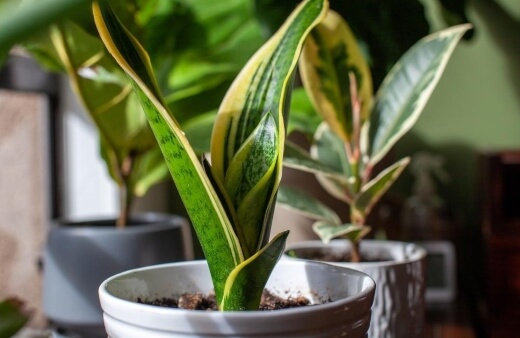
Mother-in-Law’s Tongue can fall prey to many common houseplant pests such as scales, gnats, spider mites, aphids, mealybugs, and whiteflies.
Keeping your plant healthy is your best defence against an insect invasion. Insects will usually attack a plant struggling with incorrect water levels, humidity, and air circulation.
If you notice insects on your plant, you can remove them by picking them off, using a gentle spray of water, or with an organic neem oil.
Dracaena trifasciata is one of the easiest plants to maintain and keep alive, whether you've got a green thumb or not. The biggest health problems are usually around overwatering, which causes plant diseases like fungal infections and root rot.
Here are some other common problems to look out for:
Smelly soil
If the soil smells like it's rotting, the plant likely has root rot. You can scoop out some of the soil and smell it. You can try to save the plant, but will need to check the roots to determine if you've saved the root system in time.
Pull the root ball out of the container and cut away any brown, mushy roots or leaves. Repot a piece of healthy root rhizome in fresh and well-draining potting mix.
Yellow or brown leaves
Healthy Dracaena trifasciata leaves are green with silver or yellow streaks. Yellow or brown leaves can mean overwatering, pest infestation, and root rot.
You can fix all of these conditions if you manage the plant's water level correctly. Overwatering causes root rot and stresses out the plant, which then leads to pests.
Curling leaves
Thrips are a common pest that can cause curling leaves. Use a magnifying glass to inspect your plant's leaves closely for the tiny black bugs. You can cut away severely curled leaves and spray the plant with neem oil to keep the pests at bay. New leaves will eventually grow back.
Leaves falling over/drooping
Healthy leaves of the Mother-in-Law’s Tongue plant grow upward and stay up, but too much water, not enough light, or bad potting mix can make the plant's leaves droop or flop over.
If you don't use a well-draining potting mix, the soil becomes soggy and this affects the leaves. Try moving the plant to a brighter spot, cut down on watering, and change the soil to a better draining one.
For more on pests and plant diseases, check out our gardening tips section for advice on how to keep unwanted visitors away.
Mother in Law's Tongue FAQs
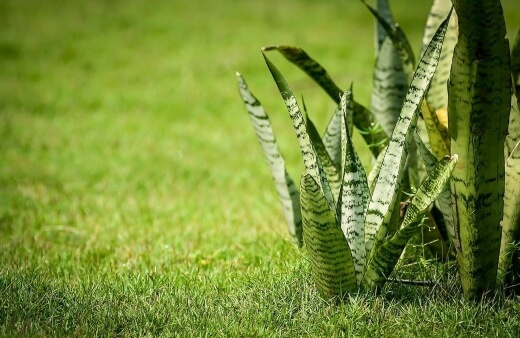
How fast does Mother-in-Law’s Tongue grow?
The snake plant is a slow grower but if you place it outdoors in summer, it might get a growing boost.
How long does Mother-in-Law’s Tongue live?
The average lifespan is five to ten years, but they can live up to 25 years or more.
How do I get a Mother-in-Law’s Tongue plant to bloom?
These plants produce creamy-white, tubular flowers that look like lilies. It flowers annually if the water, sun, and humidity needs are met. If you grow Mother-in-Law’s Tongue indoors, they rarely produce flowers.
What is the cultural significance of Mother-in-Law’s Tongue?
In its native Africa, a yellow-tipped cultivar of this plant is associated with Oya, the female Orisha of storms. In Nigeria it is commonly linked with Ogun, the Orisha of war.
It is used in rituals to remove the evil eye. In Brazil, its common name Espada de São Jorge is linked to Saint George.
Does Mother-in-Law’s Tongue have any medicinal properties?
The plant is used to treat ringworm and fungal diseases. The leaf sap can be applied directly to infected sores, cuts and grazes.
Does Mother-in-Law’s Tongue help you sleep?
This plant is a natural air purifier and emits oxygen at night that can help you sleep better. It's also known to remove harmful chemicals from the air such as xylene, trichloroethylene, toluene, benzene and formaldehyde.
Does a Mother-in-Law’s Tongue plant attract mosquitoes?
These plants actually repel mosquitoes as they naturally produce a chemical called Saponin, which is neurotoxic to mosquitoes and other insects.
How much oxygen does a Mother-in-Law’s Tongue plant produce?
According to NASA's Clean Air Study, this plant is so effective in producing oxygen that if you were locked in a sealed room with no airflow, you would be able to survive with just 6-8 plants in it.

Growing Mother in Law's Tongue is Perfect both Indoors and Outdoors
Mother-in-Law’s Tongue (Dracaena trifasciata) has so many benefits. It’s excellent for decoration – in fact the more the merrier. The plant is a mental health booster and air purifier.
This is the kind of décor you want – beautiful and good for you. Low maintenance and easy to propagate, the snake plant, or Mother-in-Law’s Tongue, is a welcome addition to any home.
If you’re just starting out with gardening, or have a history of killing houseplants (don’t worry, we’re not judging), then perhaps this is a good place to start. You might love Mother in Law's Tongue so much that you end up filling your whole home and outdoor garden with them.
Published on May 30, 2022 by Maisie Blevins
Last Updated on February 26, 2024




